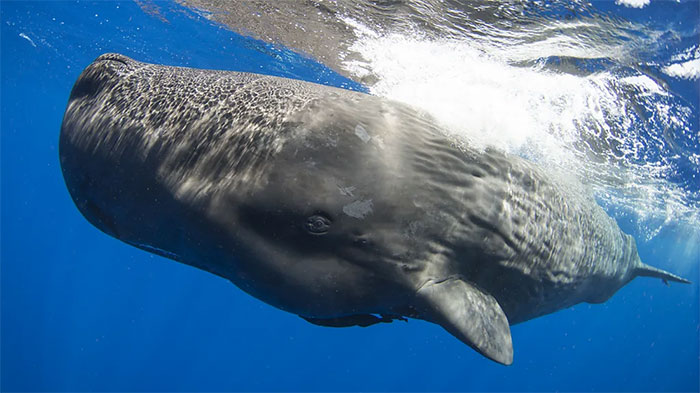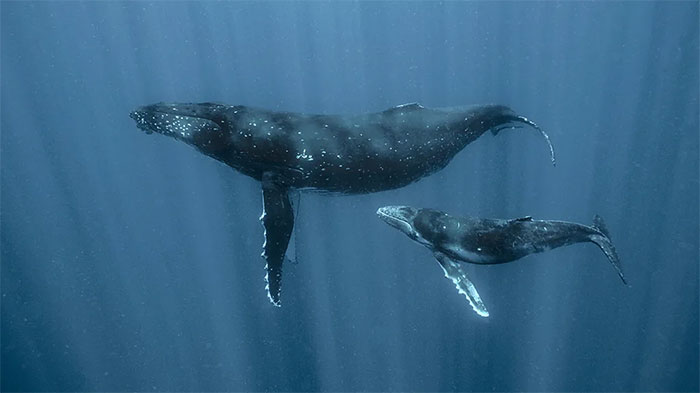Researchers learn the language of... whales and sperm whales
For the first time in the world, researchers had a 'conversation' with a whale. Now their goal is to try to find out what it's actually saying.
A growl emanated from the underwater speakers of the research vessel off the coast of Frederick Sound , Alaska (USA). A humpback whale broke away from its pod and approached. It surfaced and then sank back down, echoing the call.

A sperm whale.
In 2021, off the coast of Southeast Alaska, a team of six scientists played a recording of a humpback whale's greeting using underwater speakers. They were stunned when a humpback whale, named Twain , responded. After 'chatting' with the whale, researchers say this encounter could be the first turning point in communication with intelligent non-human animals . 'It was like an otherworldly experience. You hear them rising to the surface. Then there was a loud gasp, then you could see them gathering together in a group. It was an unbelievable sight,' said Josie Hubbard, an animal behaviorist.

A humpback whale and its calf.
Ms. Hubbard was on the research ship when she encountered humpback whales for the first time. Below deck, acoustician Brenda McCowan is broadcasting a recorded whale call through an underwater speaker. Twain 'responded' , engaging in a 'conversation' that lasted up to 20 minutes.
Rhythmic and ever-evolving, whales' haunting songs can echo across the ocean. They converse with whistles and beats, or use echolocation to paint pictures of the underwater world. Whales have fascinated humans for centuries, and they have a long list of behaviors similar to ours.
They cooperate with each other as well as with other species. They teach each other useful skills, take care of their children and know how to play. However, unlike humans, whales' dominant sense is not sight but hearing. While light will disappear about 200m below the ocean's surface, sound can travel farther and faster in water than in air.

Scientists placed microphones in the ocean to record sperm whale calls.
Crustaceans have evolved over 50 million years to produce and hear a variety of complex sounds. It's how they communicate, navigate, find mates and food, protect their territory and resources, and avoid predators. Their young babble like newborn babies, some seem to have names, and flocks from different parts of the ocean form entire dialects. Scientists have heard whales imitate the dialects of other groups, and some are even believed to have tried speaking human languages.
The song of the humpback whale is said to be one of the most complex sounds in the animal kingdom. The first recording of humpback whale song was made in 1952 by US Navy engineer Frank Watlington. Nearly 20 years later, marine biologist Roger Payne noticed that these calls tended to repeat. This transformed our understanding of whale vocalizations and in turn led to decades of research.
Today, the SETI research team hopes that decoding whale communications can help us understand aliens, in case we encounter them. The team hypothesizes that whale sounds contain complex, intelligent messages similar to human language, or possibly alien-like. However, Ms McCowan said, our understanding of how whales communicate is still very early. 'We are still in the early stages. A big challenge for us is to classify the whale signals and find their context, so we can determine the meaning. I think AI will help us do that ,' she said.
More than 8,000 km away in Alaska, a team of natural language processing and artificial intelligence experts, cryptographers, linguists, marine biologists, robotics experts and underwater acousticians are also hoping AI can decode sperm whale conversations.
Launched in 2020, CETI (The Crustacean Translation Project), led by marine biologist David Gruber, continuously recorded a group of whales off the coast of Dominica, an island in the Caribbean, using microphones mounted on buoys, robotic fish and tags attached to whales' backs.
'Except for very brief interactions on the water, it's difficult for us to peer into their world. This is a unique, gentle and intelligent creature. Every time we look back, we find more complexity and deep structure in their communication,' Mr. Gruber said. He believes that with current levels of technological advancement, we have the ability to decode whale communications.
The data collected was processed using machine learning algorithms to detect and classify the calls, and the results will be published this year. Mr Gruber said the aim now is to be able to recreate 'a multi-stakeholder conversation'. In other words, create a dialogue using the sperm whale's own vocalizations. But even if we could talk to whales, should we? For example, the ability to call whales can be used to hunt them.
New technologies have aided hunters before. Sonar has been used to locate and lure whales to the surface, where they can be more easily shot. This is the dark side.
- Whales can ... learn a foreign language
- Rare photos of sperm whales
- Detecting giant whale carcasses in England
- Scientists find ways to talk to sperm whales, what will they tell us?
- Why are sperm whales not infected with scuba diving?
- The sperm whale died on the English coast with a plastic sheet in his stomach
- The feud of the ocean: giant squid and sperm whale
- Why ambergris are more expensive than gold?
- Sperm whales are stranded in Australia
- Sperm whales work together to look after children
- Close up of killer whales hunting giant sperm whales
- Fact: Whale in English is called 'sperm fish', why?
 Surprised: Fish that live in the dark ocean still see colors
Surprised: Fish that live in the dark ocean still see colors Japan suddenly caught the creature that caused the earthquake in the legend
Japan suddenly caught the creature that caused the earthquake in the legend A series of gray whale carcasses washed ashore on California's coast
A series of gray whale carcasses washed ashore on California's coast Compare the size of shark species in the world
Compare the size of shark species in the world